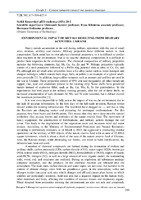ENVIRONMENTAL IMPACT OF METALS RESULTING FROM MILITARY ACTIVITIES: UKRAINE

Mostra/
Data
2022Autore
Krasovskyi, Serhii
Kovrov, Oleksandr
Klimkina, Iryna
Metadata
Mostra tutti i dati dell'itemAbstract
Heavy metals accumulate in the soil during military operations with the use of small
arms, mortars, artillery and rockets. Military projectiles have different metals in their
composition. Each metal has its own physico-chemical properties, so it is difficult to predict
their reactions in the environment. Due to its specific chemical composition, it is difficult to
predict their migration in the environment. The chemical composition of military projectiles
includes the following elements: Ld, Sb, Cu, As, Zn and W. Military projectiles typically
consist of a steel penetrator followed by a Pb/Sb slug jacketed with an alloy of Cu, Zn, and
Pb, although not all small arms projectiles have a Cu alloy jacket such as some handgun and
shotgun cartridges, which contain bare slugs, balls, or pellets is an example of a typical small arms projectile [1]. In addition, large-caliber weapons such as mortars and artillery are used in
the war in Ukraine. These projectiles consist of 95% iron and manganese, all other metals are
copper, zinc, lead and aluminum present in the rotating strip. Some shells have powdered
metals instead of explosive filler, such as Ba, Cu, Mn, K, Sr for pyrotechnics. In the
experiments that took place at the military training grounds, after the use of these shells, an
increased concentration of such elements Al, Mn, and Ni were recorded, but it did not exceed
the maximum permissibleHeavy metals accumulate in the soil during military operations with the use of small
arms, mortars, artillery and rockets. Military projectiles have different metals in their
composition. Each metal has its own physico-chemical properties, so it is difficult to predict
their reactions in the environment. Due to its specific chemical composition, it is difficult to
predict their migration in the environment. The chemical composition of military projectiles
includes the following elements: Ld, Sb, Cu, As, Zn and W. Military projectiles typically
consist of a steel penetrator followed by a Pb/Sb slug jacketed with an alloy of Cu, Zn, and
Pb, although not all small arms projectiles have a Cu alloy jacket such as some handgun and
shotgun cartridges, which contain bare slugs, balls, or pellets is an example of a typical small arms projectile. In addition, large-caliber weapons such as mortars and artillery are used in
the war in Ukraine. These projectiles consist of 95% iron and manganese, all other metals are
copper, zinc, lead and aluminum present in the rotating strip. Some shells have powdered
metals instead of explosive filler, such as Ba, Cu, Mn, K, Sr for pyrotechnics. In the
experiments that took place at the military training grounds, after the use of these shells, an
increased concentration of such elements Al, Mn, and Ni were recorded, but it did not exceed
the maximum permissible.
